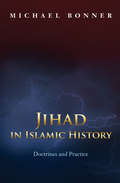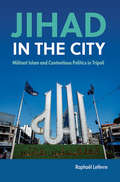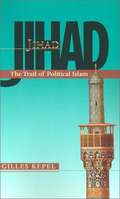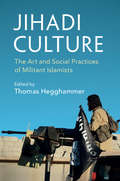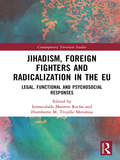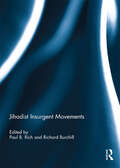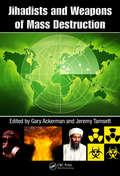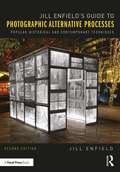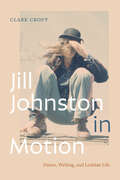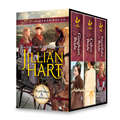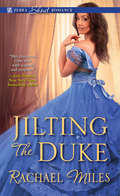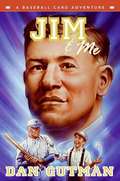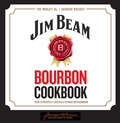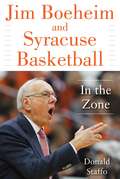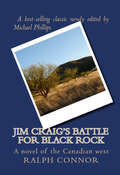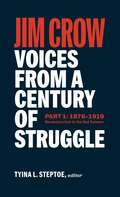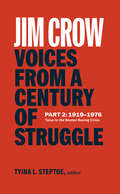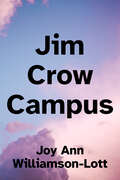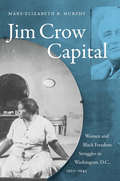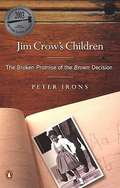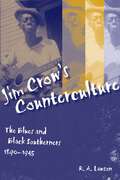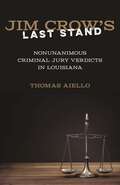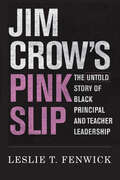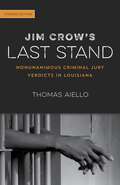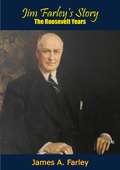- Table View
- List View
Jihad in Islamic History: Doctrines and Practice
by Michael BonnerWhat is jihad? Does it mean violence, as many non-Muslims assume? Or does it mean peace, as some Muslims insist? Because jihad is closely associated with the early spread of Islam, today's debate about the origin and meaning of jihad is nothing less than a struggle over Islam itself. In Jihad in Islamic History, Michael Bonner provides the first study in English that focuses on the early history of jihad, shedding much-needed light on the most recent controversies over jihad. To some, jihad is the essence of radical Islamist ideology, a synonym for terrorism, and even proof of Islam's innate violence. To others, jihad means a peaceful, individual, and internal spiritual striving. Bonner, however, shows that those who argue that jihad means only violence or only peace are both wrong. Jihad is a complex set of doctrines and practices that have changed over time and continue to evolve today. The Quran's messages about fighting and jihad are inseparable from its requirements of generosity and care for the poor. Jihad has often been a constructive and creative force, the key to building new Islamic societies and states. Jihad has regulated relations between Muslims and non-Muslims, in peace as well as in war. And while today's "jihadists" are in some ways following the "classical" jihad tradition, they have in other ways completely broken with it. Written for general readers who want to understand jihad and its controversies, Jihad in Islamic History will also interest specialists because of its original arguments.
Jihad in the City: Militant Islam and Contentious Politics in Tripoli
by Raphaël LefèvreTawhid was a militant Islamist group which implemented Islamic law at gunpoint in the Lebanese city of Tripoli during the 1980s. In retrospect, some have called it 'the first ISIS-style Emirate'. Drawing on two hundred interviews with Islamist fighters and their mortal enemies, as well as on a trove of new archival material, Raphaël Lefèvre provides a comprehensive account of this Islamist group. He shows how they featured religious ideologues determined to turn Lebanon into an Islamic Republic, yet also included Tripolitan rebels of all stripes, neighbourhood strongmen with scores to settle, local subalterns seeking social revenge as well as profit-driven gangsters, who each tried to steer Tawhid's exercise of violence to their advantage. Providing a detailed understanding of the multi-faceted processes through which Tawhid emerged in 1982, implemented its 'Emirate' and suddenly collapsed in 1985, this is a story that shows how militant Islamist groups are impacted by their grand ideology as much as by local contexts – with crucial lessons for understanding social movements, rebel groups and terrorist organizations elsewhere too.
Jihad: The Trail of Political Islam
by Gilles Kepel Anthony F. RobertsThe late twentieth century has witnessed the emergence of an unexpected and extraordinary phenomenon: Islamist political movements. Beginning in the early 1970s, militants revolted against the regimes in power throughout the Muslim world and exacerbated political conflicts everywhere. Their jihad, or "Holy Struggle," aimed to establish a global Islamic state based solely on a strict interpretation of the Koran. Religious ideology proved a cohesive force, gathering followers ranging from students and the young urban poor to middle-class professionals. After an initial triumph with the Islamic revolution in Iran, the movement waged jihad against the USSR in Afghanistan, proclaiming for the first time a doctrine of extreme violence. By the end of the 1990s, the failure to seize political power elsewhere led to a split: movement moderates developed new concepts of "Muslim democracy" while extremists resorted to large-scale terrorist attacks around the world. Jihad is the first extensive, in-depth attempt to follow the history and geography of this disturbing political-religious phenomenon. Fluent in Arabic, Kepel has traveled throughout the Muslim world gathering documents, interviews, and archival materials inaccessible to most scholars, in order to give us a comprehensive understanding of the scope of Islamist movements, their past, and their present. As we confront the threat of terrorism to our lives and liberties, Gilles Kepel helps us make sense of the ominous reality of jihad today.
Jihadi Culture: The Art and Social Practices of Militant Islamists
by Thomas HegghammerAl-Qaida and Islamic State continue to captivate the world with their extreme violence. While much attention has been given to the operations and doctrines of jihadi groups, this is the first book to explore their culture. Using a wealth of primary sources, the authors examine what goes on inside these organizations and what daily life is like for the foot-soldiers. They show that Islamist militants have a rich aesthetic culture and do much more than fight and train. Life in a jihadi group is in fact filled with poetry and music, and fighters spend time on surprising things like dream interpretation and weeping. Readers will discover an entirely new perspective on radical Islamists: that despite their reputation as macho men, they value humility, artistic sensitivity, and displays of emotion. Cultural practices are essential for understanding the jihadi worldview and may shed important new light on decision-making and recruitment processes in extremist groups. This original book will interest anyone in academia, government, or the general public who is intrigued by the appeal and resilience of the jihadi movement.
Jihadism, Foreign Fighters and Radicalization in the EU: Legal, Functional and Psychosocial Responses (Contemporary Terrorism Studies)
by Inmaculada Marrero Rocha Humberto M. Trujillo MendozaJihadism, Foreign Fighters and Radicalization in the EU addresses the organizational and strategic changes in terrorism in Europe as a result of urban jihadism and the influx of foreign fighters of European nationality or residence. Examining the different types of responses to the treatment of radicalization and its consequences in the recruitment of young urban fighters and jihadists, this book offers a framework for understanding the process of violent radicalization. It critically analyses political and legal responses that have taken place within the European framework, whilst also examining a series of functional responses from social and behavioural psychology. This book then goes on to develop an explanatory model from an economic standpoint, exploring the need to adapt the fight against the financing of terrorism to the changes in the sources of financing jihadist cells and foreign fighters. Furthermore, the volume draws on experience from the prison sector to assess the process of radicalization and the possibilities of intervention. Taking an interdisciplinary approach, this book will be of great interest to students of terrorism and counter-terrorism, radicalization, European politics, radical Islam and security studies.
Jihadist Insurgent Movements
by Paul B. Rich and Richard BurchillThis path-breaking collection of papers examines the phenomenon of jihadist insurgent movements in the Middle East and North, East and West Africa. It argues that military and strategic analysts have paid insufficient attention to the phenomenon of jihadism in insurgent movements, partly due to a failure to take the role of religion sufficiently seriously in the ideological mobilisation of recruits by guerrilla movements stretching back to the era of "national liberation" after World War Two. Several essays in the collection examine Al Qaeda and ISIL as military as well as political movements while others assess Boko Haram in West Africa, Al Shabaab in Somalia and jihadist movements in Libya. Additionally, some authors discuss the recruitment of foreign fighters and the longer-term terrorist threat posed by the existence of jihadist movements to security and ethnic relations in Europe Overall, this volume fills an important niche between studies that look at Islamic fundamentalism and "global jihad" at the international level and micro studies that look at movements locally. It poses the question whether jihadist insurgencies are serious revolutionary threats to global political stability or whether, like Soviet Russia after its initial revolutionary phase of the 1920s, they can be ultimately contained by the global political order. The volume sees these movements as continuing to evolve dynamically over the next few years suggesting that, even if ISIL is defeated, the movement that brought it into being will still exist and very probably morph into new movements. Jihadist Insurgent Movements was originally published as a special issue of Small Wars & Insurgencies.
Jihadists and Weapons of Mass Destruction
by Gary Ackerman Jeremy TamsettExplores the Nexus Formed When Malevolent Actors Access Malignant MeansWritten for professionals, academics, and policymakers working at the forefront of counterterrorism efforts, Jihadists and Weapons of Mass Destruction is an authoritative and comprehensive work addressing the threat of weapons of mass destruction (WMD) in the hands of jihadists,
Jill Enfield’s Guide to Photographic Alternative Processes: Popular Historical and Contemporary Techniques (Alternative Process Photography)
by Jill EnfieldJill Enfield’s Guide to Photographic Alternative Processes, 2nd edition, is packed with stunning imagery, how-to recipes, techniques and historical information for emulating the ethereal, dream-like feel of alternative processing. This fully updated edition covers alternative processing from its historical roots through to digital manipulation and contemporary techniques and how to combine them. It features several new techniques alongside new approaches to older techniques, including hand painting on silver gelatin prints, ceramics and photography, cyanotypes, wet plate collodion, digital prints and many more. Enfield showcases the different styles and methods of contemporary artists together with suggestions for vegan and vegetarian friendly alternative processing, transforming 2D images to 3D installations, and how to apply darkroom techniques to digital captures. Professionals, students and hobbyists will discover how to bring new life and imagination to their imagery. Whether in a darkroom using traditional chemicals, at the kitchen sink with pantry staples, or in front of the computer re-creating techniques digitally, you will learn how to add a richness and depth to your photography like never before.
Jill Johnston in Motion: Dance, Writing, and Lesbian Life
by Clare CroftPerformer, activist, and writer Jill Johnston was a major queer presence in the history of dance and 1970s feminism. She was the first critic to identify postmodernism’s arrival in American dance and was a fierce advocate for the importance of lesbians within feminism. In Jill Johnston in Motion, Clare Croft tracks Johnston’s entwined innovations and contributions to dance and art criticism and activism. She examines Johnston’s journalism and criticism—in particular her Village Voice columns published between 1960 and 1980—and her books of memoir and biography. At the same time, Croft attends to Johnston’s appearances as both dancer and audience member and her physical and often spectacular participation at feminist protests. By bringing together Johnston’s criticism and activism, her writing and her physicality, Croft emphasizes the effect that the arts, particularly dance, had on Johnston’s feminist thinking in the 1970s and traces lesbian feminism’s roots in avant-garde art practice.
Jillian Hart Buttons and Bobbins Box Set
by Jillian HartNew York Times bestselling author Jillian Hart will capture your heart with these sweet stories of new romance in her Buttons & Bobbins series. Enjoy three heartwarming books in one great box set! GINGHAM BRIDE An arranged marriage bargain made long ago brings together a woman who doesn't believe in love and an honorable man who wants to protect her from her cruel father. CALICO BRIDE A woman who longs for adventure finds more excitement than she can handle when she helps care for the town's new deputy, who stumbles into her father's mercantile, gravely injured. SNOWFLAKE BRIDE A penniless country girl can't afford dreams of romance, though her boss's handsome son makes her wish she wasn't his family's maid but his happily-ever-after. This box set includes: GINGHAM BRIDE CALICO BRIDE SNOWFLAKE BRIDE
Jilting the Duke (The Muses' Salon Series #1)
by Rachael MilesA ZEBRA SHOUT FRESH NEW ROMANCE "Her characters come alive with warmth and purpose." --Jodi Thomas, New York Times bestselling authorBroken Promise, Broken HeartAidan Somerville, Duke of Forster, is a rake, a spy, and a soldier, richer than sin and twice as handsome. Now he is also guardian to his deceased best friend's young son. The choice makes perfect sense--except that the child's mother is the lovely Sophia Gardiner, to whom Aidan was engaged before he went off to war. When the news reached him that she had married another, his ship had not yet even left the dock. Sophia does not expect Aidan to understand or forgive her. But she cannot allow him to stay her enemy. She's prepared for coldness, even vengeance--but not for the return of the heedless lust she and Aidan tumbled into ten years ago. She knows the risks of succumbing to this dangerous desire. Still, with Aidan so near, it's impossible not to dream about a second chance...
Jim & Me
by Dan GutmanHe was the world's greatest athlete, and a hero-until his medals were taken away. Stosh is shocked when his enemy, Bobby Fuller, begs him for a favor. He wants Stosh to take him back in time to meet Native American Jim Thorpe-an Olympic champion who lost his medals in a scandal. Thorpe went on to play professional baseball and football, but he could never again achieve such fame. His name was disgraced. Join Stosh and Fuller on a quest to save Jim's reputation. You'll meet Christy Mathewson, John McGraw, and the rest of the New York Giants in this eighth exciting, action-packed baseball card adventure!
Jim Beam Bourbon Cookbook: Over 70 Recipes & Cocktails to Make with Bourbon
by Editors of Thunder Bay PressKick your meals to another level by adding a touch of Jim Beam to these recipes.Since 1795, the Beam family has been producing one of the world's premier brands of bourbon whiskey. Over the course of seven generations, the recipe for Jim Beam's signature Kentucky Straight Bourbon Whiskey has remained essentially the same, making it a taste that has been enjoyed and shared over the decades. Jim Beam Bourbon Cookbook contains 70 recipes that include this classic bourbon whiskey, from appetizers to main dishes to desserts--and cocktails, of course. Ideal for backyard barbecues as well as elegant dinners, the dishes in this book will leave your guests wondering what secret ingredient has given your food such a distinctive flavor.
Jim Boeheim and Syracuse Basketball: In the Zone
by Donald StaffoFor more than forty seasons, Jim Boeheim has been one of college basketball’s most successful and compelling figures with the second-most victories of all time behind only Mike Krzyzewski. The Hall of Fame coach has led the Syracuse Orange to five Final Fours, including a memorable national championship in 2003. In Jim Boeheim and Syracuse Basketball: In the Zone, Donald Staffo examines the career of the storied SU basketball coach and the elite program that he built. Boeheim’s accomplishments as well as his considerable charitable work cannot be denied, nor can the sanctions that occurred under his watch. Both sides are covered in depth—the highs and lows that have made Boeheim a legend and Syracuse a basketball power. After taking over the program in 1977, a decade after his own playing career at the school, Boeheim transformed it into a national power behind such stars as Roosevelt Bouie, Pearl Washington, Sherman Douglas, Rony Seikaly, Derrick Coleman, Carmelo Anthony, and C. J. Fair. Staffo brings to life the wild environment in the old Manley Field House and a packed Carrier Dome. All the unforgettable moments are highlighted, including the 2003 championship win over Kansas, the epic six-overtime classic over UConn in the 2009 Big East Tournament, and the surprising run to the 2016 Final Four. It also analyzes Boeheim from a point-counterpoint standpoint as well as the image of the Syracuse basketball program compared to other hoop powers. Jim Boeheim and Syracuse Basketball is a revealing look at a basketball legend.
Jim Craig's Battle for Black Rock: A Novel of the Canadian West
by Ralph ConnorA courageous minister is out to save the souls of a frontier mining town in this nineteenth century Christian Western novel.The mountain town of Black Rock is a place where hard-living miners find respite from their labors in the fleeting pleasure of the saloon. When Pastor Jim Craig arrives, he brings with him a radically different vision of salvation—one found in the everlasting love of the Lord. Jim believes the Gospel can change lives, and he’s determined to prove it. But those who profit off of whiskey and sin are equally determined to fight his message of reform. Written by a Canadian minister and first published in 1898, Jim Craig’s Battle for Black Rock is a timeless tale of Western adventure and the power of faith.
Jim Crow (LOA #376): 1876 - 1919: Reconstruction to the Red Summer
by Jim CrowThis collection of 80 dramatic firsthand writings by Frederick Douglass, Ida B. Wells, and others brings to life the struggle for racial justice from the Civil War to World War IA vital resource for the teaching of the history of race in America that traces the ascendency of white supremacy after Reconstruction—and the outspoken resistance to it led by Black Americans and their alliesW.E.B. Du Bois famously identified "the problem of the color-line" as the defining issue in American life. The powerful writings gathered here reveal the many ways Americans, Black and white, fought against white supremacist efforts to police the color line, envisioning a better America in the face of disenfranchisement, segregation, and widespread lynching, mob violence, and police brutality.Jim Crow: Voices from a Century of Struggle, Part One brings together speeches, pamphlets, newspaper and magazine articles, public testimony, judicial opinions, letters, and poems and song lyrics—more than eighty essential texts in all—from the end of Reconstruction in 1876 to the bloody &“Red Summer&” of 1919.The volume includes writing by both famous and lesser known individuals, including:Ida B. Wells on the scourge of lynchingRichard T. Greener&’s scathing critique of America&’s &“White Problem"Charles Chesnutt on the nullification of the Fifteenth AmendmentBooker T. Washington&’s historic Atlanta addressJohn Marshall Harlan&’s eloquent and prophetic dissent in Plessy v. Ferguson;Mary Church Terrell on segregation in the nation&’s capital and the convict lease systemWilliam Monroe Trotter&’s dramatic White House confrontation with Woodrow WilsonJeanette Carter&’s tribute to the men and women who fought back against white mobs in 1919The volume also presents revealing examples of white supremacist advocacy by Nathaniel Shaler and Benjamin Tillman; testimony about the &“Exoduster&” migration to Kansas in the 1870s; celebrations of pathbreaking Black musicians and stage performers; writing about the Wilmington insurrection of 1898, the founding of the NAACP, and Black soldiers in World War I; and contrasting editorials from the Black and white press on prizefighter Jack Johnson and the outlaw Robert Charles.As the teaching of our nation&’s history, especially the history of race in America, becomes increasingly contested, this book will serve as a vital resource, a crucial reminder of where we&’ve been, how far we&’ve come, and how long the road ahead remains.
Jim Crow (LOA #387): 1919-1976: Tulsa to the Boston Busing Crisis
by Jim CrowA vivid firsthand record of the struggle for legal equality and dignity in the face of segregation and racial terror from 1919 to 1976W.E.B. Du Bois famously identified "the problem of the color-line" as the defining issue in American life. The powerful writings gathered here reveal the many ways Americans, Black and white, fought against white supremacist efforts to police the color line, envisioning a better America in the face of disenfranchisement, segregation, and widespread lynching, mob violence, and police brutality.Jim Crow: Voices from a Century of Struggle, Part Two brings together speeches, pamphlets, newspaper and magazine articles, public testimony and appeals, judicial opinions, and poems and song lyrics—more than ninety essential texts in all—from the end of the bloody &“Red Summer&” of 1919 to the Boston busing crisis of 1974–76.This volume includes writing by both famous and lesser known individuals, including• B. C. Franklin on the Tulsa Massacre• Robert Russa Moton&’s suppressed address on the dedication of the Lincoln Memorial• Alain Locke&’s tribute to &“the New Negro&”• Ned Cobb&’s recounting of the harsh realities of sharecropping• Thurgood Marshall on police brutality in wartime Detroit• Rosa Parks&’s appeal for justice for Recy Taylor• Earl Warren&’s landmark opinion in Brown • Paul Robeson&’s defiant response to congressional inquisitors• Fannie Lou Hamer&’s eloquent challenge to disenfranchisement in Mississippi• and James Baldwin on the myths and meaning of the American DreamAlso presented are white supremacist writings from the 1920s Klan and the Dixiecrats of 1948; examples of Southern voter literacy tests; blues lyrics sung by Bessie Smith and Big Bill Broonzy; Robert F. Williams&’s controversial call for armed Black self-defense; speeches by Marcus Garvey and Stokeley Carmichael; letters in the Black press about Confederate monuments; Ann Moody on her childhood in segregated Mississippi; and Mary McLeod Bethune&’s advocacy for reproductive rights as an essential element of democratic freedom.As the teaching of our nation&’s history, especially the history of race in America, becomes increasingly contested, this book will serve as a vital resource, a crucial reminder of where we&’ve been, how far we&’ve come, and how long the road ahead remains.
Jim Crow Campus: Higher Education and the Struggle for a New Southern Social Order
by Joy Ann Williamson-LottThis well-researched volume explores how the Black freedom struggle and the anti-Vietnam War movement dovetailed with faculty and student activism in the South to undermine the traditional role of higher education and bring about social change. It offers a deep understanding of the vital importance of independent institutions during times of national crisis.
Jim Crow Capital: Women and Black Freedom Struggles in Washington, D.C., 1920–1945
by Mary-Elizabeth B. MurphyLocal policy in the nation's capital has always influenced national politics. During Reconstruction, black Washingtonians were first to exercise their new franchise. But when congressmen abolished local governance in the 1870s, they set the precedent for southern disfranchisement. In the aftermath of this process, memories of voting and citizenship rights inspired a new generation of Washingtonians to restore local government in their city and lay the foundation for black equality across the nation. And women were at the forefront of this effort.Here Mary-Elizabeth B. Murphy tells the story of how African American women in D.C. transformed civil rights politics in their freedom struggles between 1920 and 1945. Even though no resident of the nation's capital could vote, black women seized on their conspicuous location to testify in Congress, lobby politicians, and stage protests to secure racial justice, both in Washington and across the nation. Women crafted a broad vision of citizenship rights that put economic justice, physical safety, and legal equality at the forefront of their political campaigns. Black women's civil rights tactics and victories in Washington, D.C., shaped the national postwar black freedom struggle in ways that still resonate today.
Jim Crow's Children
by Peter IronsIn 1954 the U. S. Supreme Court sounded the death knell for school segregation with its decision in Brown v. Board of Education of Topeka. So goes the conventional wisdom. Weaving together vivid portraits of lawyers and such judges as Thurgood Marshall and Earl Warren, sketches of numerous black children throughout history whose parents joined lawsuits against Jim Crow schools, and gripping courtroom drama scenes, Irons shows how the erosion of the Brown decision--especially by the Court's rulings over the past three decades--has led to the "resegregation" of public education in America. .
Jim Crow's Counterculture: The Blues and Black Southerners, 1890-1945 (Making the Modern South)
by R. A. LawsonIn the late nineteenth century, black musicians in the lower Mississippi Valley, chafing under the social, legal, and economic restrictions of Jim Crow, responded with a new musical form -- the blues. In Jim Crow's Counterculture, R. A. Lawson offers a cultural history of blues musicians in the segregation era, explaining how by both accommodating and resisting Jim Crow life, blues musicians created a counterculture to incubate and nurture ideas of black individuality and citizenship. These individuals, Lawson shows, collectively demonstrate the African American struggle during the early twentieth century. Derived from the music of the black working class and popularized by commercially successful songwriter W. C. Handy, early blues provided a counterpoint to white supremacy by focusing on an anti-work ethic that promoted a culture of individual escapism -- even hedonism -- and by celebrating the very culture of sex, drugs, and violence that whites feared. According to Lawson, blues musicians such as Charley Patton and Muddy Waters drew on traditions of southern black music, including call and response forms, but they didn't merely sing of a folk past. Instead, musicians saw blues as a way out of economic subservience. Lawson chronicles the major historical developments that changed the Jim Crow South and thus the attitudes of the working-class blacks who labored in that society. The Great Migration, the Great Depression and New Deal, and two World Wars, he explains, shaped a new consciousness among southern blacks as they moved north, fought overseas, and gained better-paid employment. The "me"-centered mentality of the early blues musicians increasingly became "we"-centered as these musicians sought to enter mainstream American life by promoting hard work and patriotism. Originally drawing the attention of only a few folklorists and music promoters, popular black musicians in the 1940s such as Huddie Ledbetter and Big Bill Broonzy played music that increasingly reached across racial lines, and in the process gained what segregationists had attempted to deny them: the identity of American citizenship.By uncovering the stories of artists who expressed much in their music but left little record in traditional historical sources, Jim Crow's Counterculture offers a fresh perspective on the historical experiences of black Americans and provides a new understanding of the blues: a shared music that offered a message of personal freedom to repressed citizens.
Jim Crow's Last Stand: Nonunanimous Criminal Jury Verdicts in Louisiana
by Thomas AielloThe last remnant of the racist Redeemer agenda in the Louisiana's legal system, the nonunanimous jury-verdict law permits juries to convict criminal defendants with only ten out of twelve votes. A legal oddity among southern states, the ordinance has survived multiple challenges since its ratification in 1880. Despite the law's long history, few are aware of its existence, its original purpose, or its modern consequences. At a time when Louisiana's penal system has fallen under national scrutiny, Jim Crow's Last Stand presents a timely, penetrating, and concise look at the history of this law's origins and its troubling legacy. The nonunanimous jury-verdict law originally allowed a guilty verdict with only nine juror votes, funneling many of those convicted into the state's burgeoning convict lease system. Yet the law remained on the books well after convict leasing ended. Historian Thomas Aiello describes the origins of the statute in Bourbon Louisiana-a period when white Democrats sought to redeem their state after Reconstruction-its survival through the civil rights era of the 1950s and 1960s, and the Supreme Court's decision in Johnson v. Louisiana (1972), which narrowly validated the state's criminal conviction policy. Spanning over a hundred years of Louisiana law and history, Jim Crow's Last Stand investigates the ways in which legal policies and patterns of incarceration contribute to a new form of racial inequality.
Jim Crow's Pink Slip: The Untold Story of Black Principal and Teacher Leadership
by Leslie T. FenwickJim Crow&’s Pink Slip exposes the decades-long repercussions of a too-little-known result of resistance to the Brown v. Board of Education decision: the systematic dismissal of Black educators from public schools.In 1954, the Supreme Court&’s Brown decision ended segregated schooling in the United States, but regrettably, as documented in congressional testimony and transcripts, it also ended the careers of a generation of highly qualified and credentialed Black teachers and principals. In the Deep South and northern border states over the decades following Brown, Black schools were illegally closed and Black educators were displaced en masse. As educational policy and leadership expert Leslie T. Fenwick deftly demonstrates, the effects of these changes stand contrary to the democratic ideals of an integrated society and equal educational opportunity for all students.Jim Crow&’s Pink Slip provides a trenchant account of how tremendous the loss to the US educational system was and continues to be. Despite efforts of the NAACP and other civil rights organizations, congressional hearings during the Nixon administration, and antiracist activism of the 21st century, the problems fomented after Brown persist. The book draws the line from the past injustices to problems that the educational system grapples with today: not simply the underrepresentation of Black teachers and principals, but also salary reductions, teacher shortages, and systemic inequality.By engaging with the complicated legacy of the Brown decision, Fenwick illuminates a crucial chapter in education history. She also offers policy prescriptions aimed at correcting the course of US education, supporting educators, and improving workforce quality and diversity.
Jim Crow’s Last Stand: Nonunanimous Criminal Jury Verdicts in Louisiana
by Thomas AielloA remnant of the racist post-Reconstruction Redeemer sociopolitical agenda, Louisiana’s nonunanimous jury-verdict law permitted juries to convict criminal defendants with only nine, and later ten, out of twelve votes: a legal oddity. On the surface, it was meant to speed convictions. In practice, the law funneled many convicts—especially African Americans—into Louisiana’s burgeoning convict lease system. Although it faced multiple legal challenges through the years, the law endured well after convict leasing had ended. Few were aware of its existence, let alone its original purpose. In fact, the original publication of Jim Crow’s Last Stand was one of the first attempts to call attention to the historical injustice caused by this law. This updated edition of Jim Crow’s Last Stand unpacks the origins of the statute in Bourbon Louisiana, traces its survival through the civil rights era, and ends with the successful effort to overturn the nonunanimous jury practice, a policy that officially went into effect on January 1, 2019.
Jim Farley’s Story: The Roosevelt Years
by James A. FarleyFrank, outspoken and revealing, here is the truth about two of the most controversial political figures in modern America: Franklin D. Roosevelt and Jim Farley. These are the unvarnished facts concerning the man who put Roosevelt into the White House and built up one of the most brilliantly efficient party organizations that America has ever known.Mr. Farley writes of Roosevelt the politician—a human being with human failings—and not a demigod. The full story revealed here for the first time gives a new and surprising picture of the late President, his elaborate political maneuverings, the reasons for the final break with Jim Farley.JIM FARLEY’S STORY is the hard-punching inside account of one man’s meteoric rise to the political genius of the Democratic Party...“Politically, I owe more to Jim Farley than to any other person alive, not excluding my wife!”—Franklin D. Roosevelt
